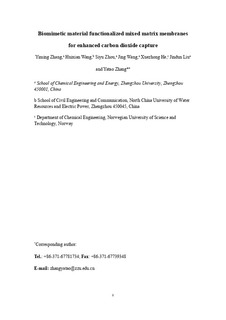| dc.contributor.author | Zhang, Yiming | |
| dc.contributor.author | Wang, Huixian | |
| dc.contributor.author | Zhou, Siyu | |
| dc.contributor.author | Wang, Jing | |
| dc.contributor.author | He, Xuezhong | |
| dc.contributor.author | Liu, Jindun | |
| dc.contributor.author | Zhang, Yatao | |
| dc.date.accessioned | 2019-06-06T13:43:21Z | |
| dc.date.available | 2019-06-06T13:43:21Z | |
| dc.date.created | 2018-07-17T21:46:54Z | |
| dc.date.issued | 2018 | |
| dc.identifier.citation | Journal of Materials Chemistry A. 2018, 6 (32), 15585-15592. | nb_NO |
| dc.identifier.issn | 2050-7488 | |
| dc.identifier.uri | http://hdl.handle.net/11250/2600206 | |
| dc.description.abstract | Carbonic anhydrase (CA) has been widely used in gas separation membranes because of its high affinity for CO2 molecules. In this work, a novel biomimetic material (Co-2,6-bis(2-benzimidazolyl)pyridine, CoBBP) which has a similar molecular structure to the CA enzyme but with higher stability and a lower price was successfully synthesized. The excellent thermal stability, dispersibility and high CO2 selectivity make CoBBP a promising alternative to CA. Then, a series of Pebax–CoBBP mixed matrix membranes were constructed to explore their capability for CO2/N2 separation. Compared to the pristine Pebax-1657, the Pebax–CoBBP mixed matrix membrane with the optimized 1.33 wt% CoBBP loading showed an improved CO2 permeability of 675.5 barrer and a CO2/N2 selectivity of 62, surpassing the Robeson upper bound (2008). Furthermore, the hydrogen bonds between CoBBP and polyamide chains improved the chain stiffness of the linear glassy polymer, ensuring good operational mechanical stability. In short, this work could provide a promising method to exploit alternatives to the CA enzyme and to fabricate biomimetic membranes. | nb_NO |
| dc.language.iso | eng | nb_NO |
| dc.publisher | Royal Society of Chemistry | nb_NO |
| dc.title | Biomimetic material functionalized mixed matrix membranes for enhanced carbon dioxide capture | nb_NO |
| dc.type | Journal article | nb_NO |
| dc.type | Peer reviewed | nb_NO |
| dc.description.version | acceptedVersion | nb_NO |
| dc.source.pagenumber | 15585-15592 | nb_NO |
| dc.source.volume | 6 | nb_NO |
| dc.source.journal | Journal of Materials Chemistry A | nb_NO |
| dc.source.issue | 32 | nb_NO |
| dc.identifier.doi | 10.1039/c8ta03198c | |
| dc.identifier.cristin | 1597710 | |
| dc.description.localcode | © 2018. This is the authors' accepted and refereed manuscript to the article. Locked until 3.7.2019 due to copyright restrictions.The final authenticated version is available online at: http://dx.doi.org/10.1039/c8ta03198c | nb_NO |
| cristin.unitcode | 194,66,30,0 | |
| cristin.unitname | Institutt for kjemisk prosessteknologi | |
| cristin.ispublished | true | |
| cristin.fulltext | original | |
| cristin.qualitycode | 1 | |
